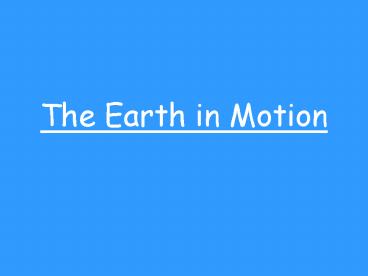The Earth in Motion - PowerPoint PPT Presentation
1 / 14
Title:
The Earth in Motion
Description:
As the plates move, the continents also move or 'drift,' over Earth's surface. ... used fossil evidence to prove the continents were 'drifting' and once formed a ... – PowerPoint PPT presentation
Number of Views:43
Avg rating:3.0/5.0
Title: The Earth in Motion
1
The Earth in Motion
2
- Our lithosphere is made up of many large plates
Oceanic and Continental - The plates are moving several cm/yr.
- As the plates move, the continents also move or
drift, over Earths surface. - German Scientist, Alfred Wegener , used fossil
evidence to prove the continents were drifting
and once formed a massive supercontinent called
Pangea.
3
Continued
- The idea that the plates are in constant slow
motion (drifting) is known as continental drift.
4
Rock Stress
- The movement of Earths plates creates powerful
forces that squeeze or pull the rock in the
crust. - These forces cause a stress on the rock.
- Shearing, tension, and compression work over time
to change the shape and volume of rock.
5
Plate Tectonics
- The motion of the plates also explains how they
interact producing - mountain ranges (uplift), earthquakes, volcanoes,
and features on the ocean floor.
6
Uplift
- The forces of plate movement can build up Earths
surface. Over millions of years, fault movement
can cause uplift, changing a flat plain into a
towering mountain range or plateau.
Mt. Everest in the Himalayas
7
- Earthquakes are a reminder that the Earths crust
is in constant motion. - An earthquake is what happens when two blocks of
the earth suddenly slip past one another. The
surface where they slip is called the fault or
fault plane.
8
Volcanoes
- During a volcanic eruption, the gases dissolved
in magma rush out, carrying the magma with them.
Once magma reaches the surface and becomes lava,
the gases bubble out.
- An erupting volcano can trigger tsunamis,
flashfloods, earthquakes, mudflows and rock
falls.
website
9
Volcano Hazards
- During a quiet eruption, lava flows pour from
vents, setting fire to and then burning
everything in their path. - During an explosive eruption, a volcano can belch
out hot, burning clouds of volcanic gas, ash,
cinders, and bombs.
10
Stages of a Volcano
- An active, or live, is one that has erupted
recently or volcanologists see the possibility of
an eruption soon. Active volcanoes are watched
very closely!
11
- A dormant, or sleeping, volcano is like a
sleeping bear it has been quiet for a long time,
but still has signs it may erupt again. A volcano
becomes dormant when the vent is blocked by
hardened lava, called a plug, or if the magma
seeps back under the earths crust.
Mt. St. Helens after 5/18/80
12
- An extinct, or dead, volcano is unlikely to erupt
again. It has not erupted for thousands of years.
Sometimes it is hard to tell if a volcano is
dormant or extinct. They will be listed as
dormant until volcanologists are sure there will
no more eruptions.
Shiprock, the erosional remnant of the throat of
an extinct volcano. (NM)
13
- There are more than 500 active volcanoes in the
world. More than half of these volcanoes are part
of the "Ring of Fire."
Kilauea volcano in Hawaii.
Sicily, Italy
Volcanic cone
14
- Zone of frequent earthquakes and volcanic
eruptions that circles the basin of the Pacific
Ocean. It is associated with a continuous series
of oceanic trenches, island arcs, volcanic
mountain ranges and plate movements.































